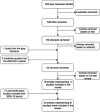The Impact of Policies to Reduce trans Fat Consumption: A Systematic Review of the Evidence
- PMID: 29955689
- PMCID: PMC5998794
- DOI: 10.3945/cdn.117.000778
The Impact of Policies to Reduce trans Fat Consumption: A Systematic Review of the Evidence
Abstract
Background: The consumption of industrially produced trans fatty acids (TFAs) has been associated with an increased risk of heart disease. In recognition of this, countries, states, and cities worldwide have implemented TFA policies aimed at reducing their availability in the food supply. Objective: This article aims to provide an update of the evidence of the effectiveness of policies aimed at reducing TFAs in the food supply. Methods: A systematic review of the literature from 2013 onward was conducted, building on a previously published review that examined the evidence of the impact of TFA policies worldwide from 2000 to 2012. Studies that were 1) empirical, 2) examined a TFA policy, and 3) examined the effect of the policy on TFA amounts and availability pre- and post-policy intervention were included. Modeling studies examining the impact of TFA policies on cardiovascular, equity, and economic outcomes were also included. Results: A total of 18 articles from the updated search were combined with 14 articles from the previous review (total = 32 articles). All types of TFA policies led to their reduction; however, trans fat bans had a larger impact (TFAs virtually eliminated) than did voluntary (range: 20-38% reduction in TFA intakes) or labeling (range: 30-74% reduction in TFA intakes, plasma serum, or breast-milk concentrations) approaches to reducing TFA amounts in the food supply. Product reformulation to reduce TFAs had variable effects on saturated fatty acid (SFA) contents in these foods; however, the combined amount of TFAs and SFAs declined in most products. Overall, the modeling studies indicated that TFA bans would reduce heart disease risk, benefit socioeconomically disadvantaged populations the most, and be cost-saving. Conclusions: Policies aimed at reducing TFAs in the food supply are effective and will likely reduce the burden of diet-related disease, particularly among the most vulnerable socioeconomic groups. Although all policy approaches lead to reductions in TFAs in foods, TFA bans are likely the most effective, economical, and equitable policy approach to reducing TFAs in the food supply.
Keywords: bans; cardiovascular disease prevention; labeling; nutrition policy; trans fatty acids.
Figures
Similar articles
-
Estimated health benefits, costs, and cost-effectiveness of eliminating industrial trans-fatty acids in Australia: A modelling study.PLoS Med. 2020 Nov 2;17(11):e1003407. doi: 10.1371/journal.pmed.1003407. eCollection 2020 Nov. PLoS Med. 2020. PMID: 33137090 Free PMC article.
-
trans Fatty acids in the Canadian food supply: an updated analysis.Am J Clin Nutr. 2014 Oct;100(4):1116-23. doi: 10.3945/ajcn.114.088732. Epub 2014 Aug 6. Am J Clin Nutr. 2014. PMID: 25099549
-
Mandatory trans fat labeling regulations and nationwide product reformulations to reduce trans fatty acid content in foods contributed to lowered concentrations of trans fat in Canadian women's breast milk samples collected in 2009-2011.Am J Clin Nutr. 2014 Oct;100(4):1036-40. doi: 10.3945/ajcn.113.078352. Epub 2014 Jul 23. Am J Clin Nutr. 2014. PMID: 25057152
-
On account of trans fatty acids and cardiovascular disease risk - There is still need to upgrade the knowledge and educate consumers.Nutr Metab Cardiovasc Dis. 2022 Aug;32(8):1811-1818. doi: 10.1016/j.numecd.2022.05.010. Epub 2022 May 26. Nutr Metab Cardiovasc Dis. 2022. PMID: 35753860 Review.
-
A Systematic Review of Trans Fat Reduction Initiatives in the Eastern Mediterranean Region.Front Nutr. 2021 Nov 26;8:771492. doi: 10.3389/fnut.2021.771492. eCollection 2021. Front Nutr. 2021. PMID: 34901118 Free PMC article.
Cited by
-
Enhancing Capacity for Food and Nutrient Intake Assessment in Population Sciences Research.Annu Rev Public Health. 2023 Apr 3;44:37-54. doi: 10.1146/annurev-publhealth-071521-121621. Epub 2022 Dec 16. Annu Rev Public Health. 2023. PMID: 36525959 Free PMC article. Review.
-
Trans Fatty Acid Biomarkers and Incident Type 2 Diabetes: Pooled Analysis of 12 Prospective Cohort Studies in the Fatty Acids and Outcomes Research Consortium (FORCE).Diabetes Care. 2022 Apr 1;45(4):854-863. doi: 10.2337/dc21-1756. Diabetes Care. 2022. PMID: 35142845 Free PMC article.
-
Molecular Approaches Reduce Saturates and Eliminate trans Fats in Food Oils.Front Plant Sci. 2022 Jun 2;13:908608. doi: 10.3389/fpls.2022.908608. eCollection 2022. Front Plant Sci. 2022. PMID: 35720592 Free PMC article. Review.
-
Trans isomeric fatty acids in human milk and their role in infant health and development.Front Nutr. 2024 Mar 7;11:1379772. doi: 10.3389/fnut.2024.1379772. eCollection 2024. Front Nutr. 2024. PMID: 38515522 Free PMC article. Review.
-
Estimated health benefits, costs, and cost-effectiveness of eliminating industrial trans-fatty acids in Australia: A modelling study.PLoS Med. 2020 Nov 2;17(11):e1003407. doi: 10.1371/journal.pmed.1003407. eCollection 2020 Nov. PLoS Med. 2020. PMID: 33137090 Free PMC article.
References
-
- Mozaffarian D, Katan MB, Ascherio A, Stampfer MJ, Willett WC.. Trans fatty acids and cardiovascular disease. N Engl J Med 2006;354:1601–13. - PubMed
-
- Teegala SM, Willett WC, Mozaffarian D.. Consumption and health effects of trans fatty acids: a review. J AOAC Int 2009;92:1250–7. - PubMed
-
- Mozaffarian D, Jacobson MF, Greenstein JS.. Food reformulations to reduce trans fatty acids. N Engl J Med 2010;362:2037–9. - PubMed
-
- World Economic Forum; WHO. From burden to “best buys”: reducing the economic impact of non-communicable diseases in low- and middle-income countries. Geneva (Switzerland): World Economic Forum; 2011.
-
- Micha R, Khatibzadeh S, Shi P, Fahimi S, Lim S, Andrews KG, Engell RE, Powles J, Ezzati M, Mozaffarian D Global Burden of Diseases Nutrition and Chronic Diseases Expert Group NutriCoDE . Global, regional, and national consumption levels of dietary fats and oils in 1990 and 2010: a systematic analysis including 266 country-specific nutrition surveys. BMJ 2014;348:g2272. - PMC - PubMed
LinkOut - more resources
Full Text Sources
Other Literature Sources


